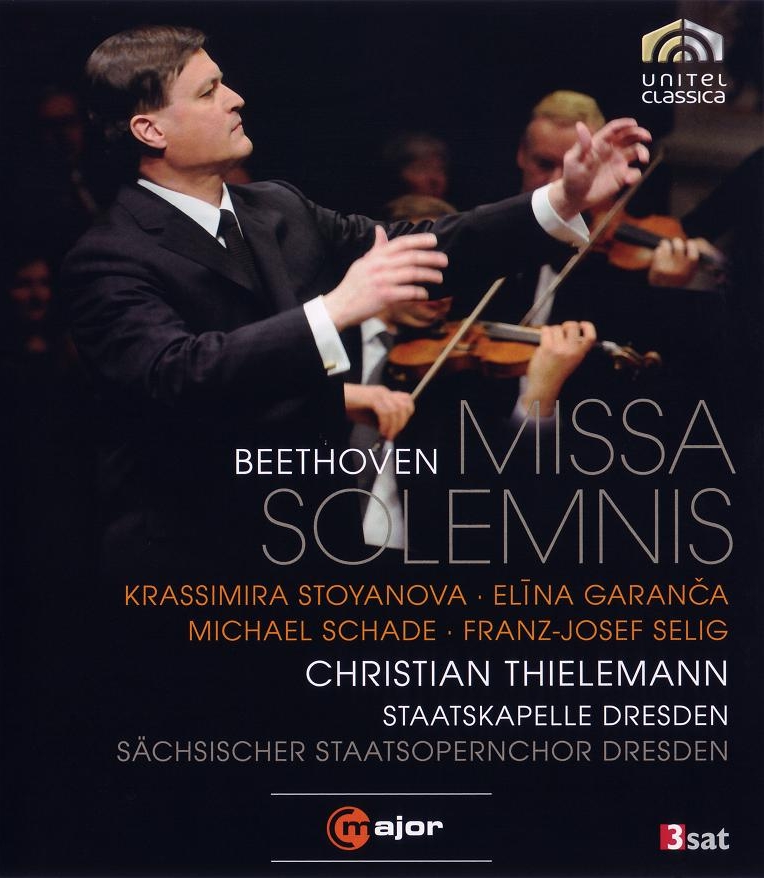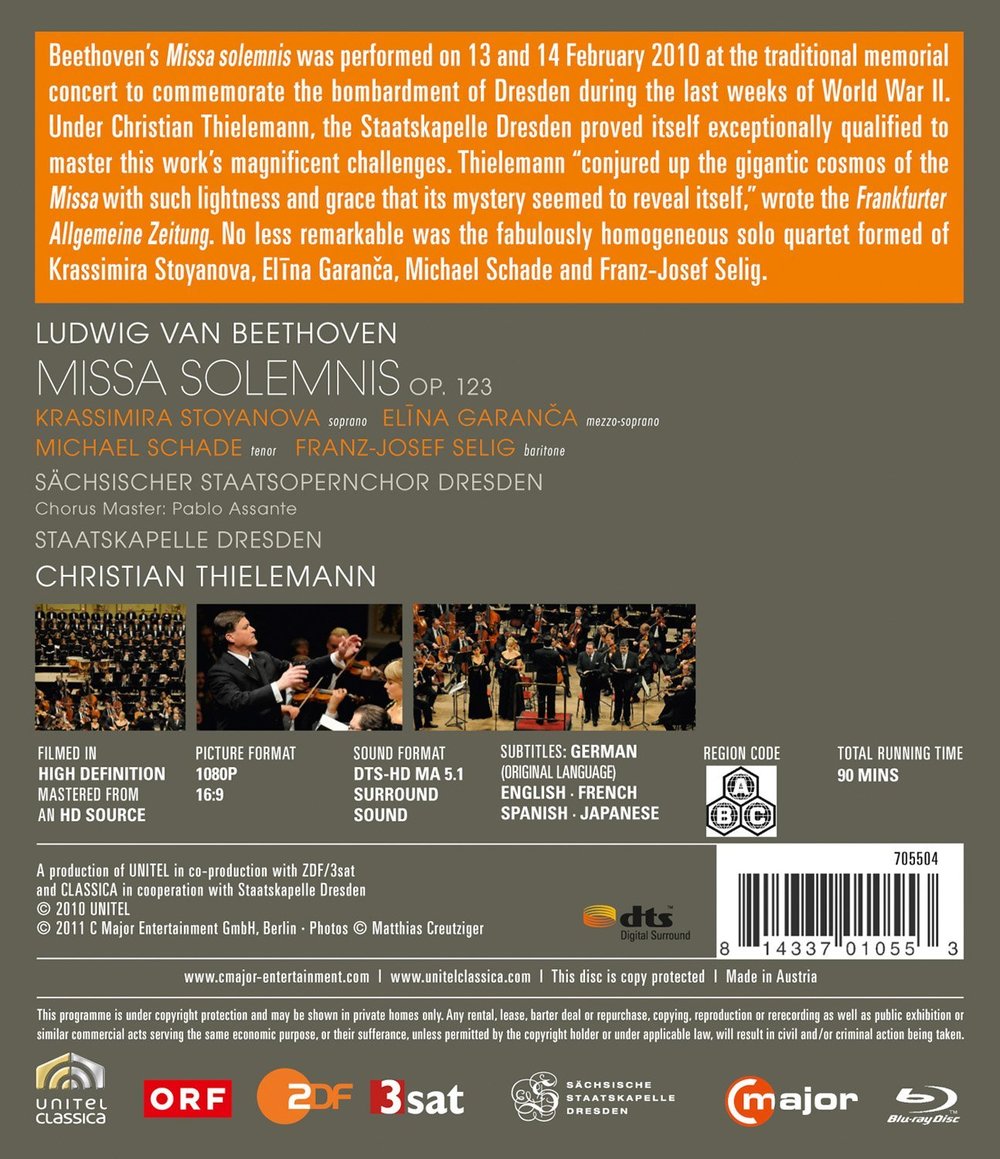

Beethoven Missa solemnis concert. Christian Thielemann conducts the Staatskapelle Dresden and Sächsischer Staatsopernchor Dresden (chorus master Pablo Assante) in 2010. Stars soloists Krassimira Stoyanova (soprano), Elīna Garanča (mezzo), Michael Schade (tenor), and Franz-Josef Selig (bass). Violin solo by Matthias Wollong. Directed for TV by Michael Beyer. Released in 2011, disc has 5.1 dts-HD Master Audio sound. Grade: C+
Even though it's supposed to be one of Beethoven's supreme works, I've never heard Missa Solemnis live. I guess it's too hard to perform for most churches and too intensely religious to fit well in secular halls. Nor does Arkivmusic recommend any of the 5 legacy DVDs on the market. Arkivmusic does recommend subject title and the Harnoncourt Blu-ray with the Concertgebauw (also from C Major).
This Thielemann performance is all-around magnificent. You also get a strong sense of the special event behind the performance: the annual memorial concert at the Semperoper to remember the bombing of Dresden shortly before the end of World War II.
The print critics went for this recording like starving gorillas turned loose in a banana farm. Ivan March, writing a review in the July 2011 Gramophone (page 94) heaped praised the DVD version. He was impressed by the good quality of the video "especially noticeable on relatively modest reproducing equipment, with the speakers either side of the TV set." Oh, can you grasp that! What would poor March have thought if he had seen the Blu-ray in HD and dts-Master Audio surround sound? Also, Matthew Gurewitsch, writing in the August 2011 Opera News (pages 62-63) states, "On a trajectory that ranges from driven Miltonic immensity to stillness on the verge of Nirvana, Thielemann maintians above all a sense of evolving wonder."
So we are off to a good start. I jump in with 5 screenshots about the event. The first shot is at the end of the performance when, by tradition, the audience rises to remain silent for one minute, and then leaves without applause:
The view below comes from the opening and shows everyone dressed (like the musicians) in black and white:
The guest of honor was Mikhail Gorbachev:
Elīna Garanča seems transported in the concluding Agnus Dei:
The performance is over and we see Beethoven's famous dedication comment for Missa solemnis:
Below is the best whole-orchestra (WO) view in the video. There are 20 shots that qualify as WO views, but you don't see this really good one until 11:31 late in the Kyrie:
There are quite a few WO shots like the one below. The weakness here is that the camera is too far back. The orchestra and chorus together only take up about 25% of the screen:
At the beginning (2:26 in the Kyrie), we get the strange conductor-over-backs (C/B) shot seen below. This is, of course, not a view of the performers at all. It's an architectural shot that's designed to impress the home viewer again with the importance of the event. This was very impressive when seen the first time — like a note of safron in the first course of a fine meal. A problem develops later when this view is repeated 25 times (total of 26). One does not want to eat a quart of safron:
There are 683 clips in this video (in long panning shots, each tableaux is counted as a clip). 256 clips are shots of single musicians or choral singers or small groups of them. Next below is concert master Wollong playing his famous solo in the Santus:
Below is a typical small group playing as part of a larger ensemble. Why would the videographer make so many shots of tiny fragments of the orchestra in a piece where large groups of 170 musicians or so seem to be engaged most of the time?
Only rarely are there shots of large groups of the musicians in the orchestra. Next below is a rare shot of various winds playing together:
Next below is one of only several shots of the cellos:
Below is, I think, the only shot of the violas playing as a section:
So far, what we have seen of the video of the orchestra would result in a diagnosis of a virilent infection of DVDitis (more about this below). But when there are soloist singers and a chorus in the a work, it is easier to produce a good video than when the orchestra only is playing. The next two shots show the female soloists in close-ups, which are also markers for DVDitis. First we see Stoyanova, and then Garanča:
We consider soloists shots from the waist up to be large-scale. Here we see Schade on the left and Selig on the right. Here we will cheat a bit by allowing that a shot that shows the elbows is large-scale:
The view next below is clearly a large-scale shot under our concepts. There are enough nice shots like this to substantailly improve the quality of the video:
Next come two small scale shots from the chorus (markers for DVDitis):
But we also enjoy quite a few large-scale shots of the chorus as you see in the next two shots below:
Finally, let's consider some weak or erroneous shots that hurt the video. There are no fewer than 94 shots that show the Thielemann over the backs of musicians such as the one next below. Beyer even racks up a ridiculous triple-play (3 conductor shots in a row) at 33:39 - 34:02 - 34:12. (Check me out.):
There are too many shots of this clarinett player, who seems to sit in a chair that's easy for several camermen to frame. Too many close-ups like this rob the customer of his right to see the big picture and focus on what's interesting to him:
There are too many inane instrument-only angles like this:
Is this a whole-orchestra shot or an ant-hill view?
The pictures above give you isolated examples of what's in this video. How does one form any judgment about a film with 683 clips? Well, one runs the numbers on a Wonk Worksheet. This I did and came up with the following statistics:
Conductor clips = 54
C/B clips = 94
Non-realistic soloist clips = 77
*Realistic soloists clips = 72
Solos, small section, small group clips = 256
*Large section, large group clips = 58
*Part orchestra clips =31
*Whole orchestra clips = 20
Instrument only clips = 21
There are 83 minutes and 37 seconds of music. Divide this by 683 clips and we see that the pace of this recording is 7.3 seconds per clip. This is slower than a pure DVD but faster than the 10 seconds or more per clip that's characteristic of a good HDVD. So this recording flunks the pace test. Thanks to the many large-scale shots of the soloists and the chorus, there are 181 total large-scale or supershots. The supers make up 26% of total clips, which passes the supershot test. There are 148 conductor shots which is 21% of total clips. So this video flunks the conductor shot test, largely because of Michael Beyer's quart of safron.
Now to figure a grade, starting with A+. We deduct a + for not having 96kHz/24-bit sound sampling. Flunking two of the 3 DVDitis tests reduces the grade from A to C. Thanks to the fine performance and the importance of the memorial event with Gorbachev as guest, we go up further to C+. This is probably one of the best recordings of Missa solemnis available, but I think it's overshadowed now by the Harnoncourt Blu-ray made later at the Concertgebouw.
We have gone to a lot of trouble to analyze the content of this video. We do this to give you proper advice and to challenge the industry as follows: start making classical music videos that take full advantage of state-of-the-art sound and HD video!
OR

























